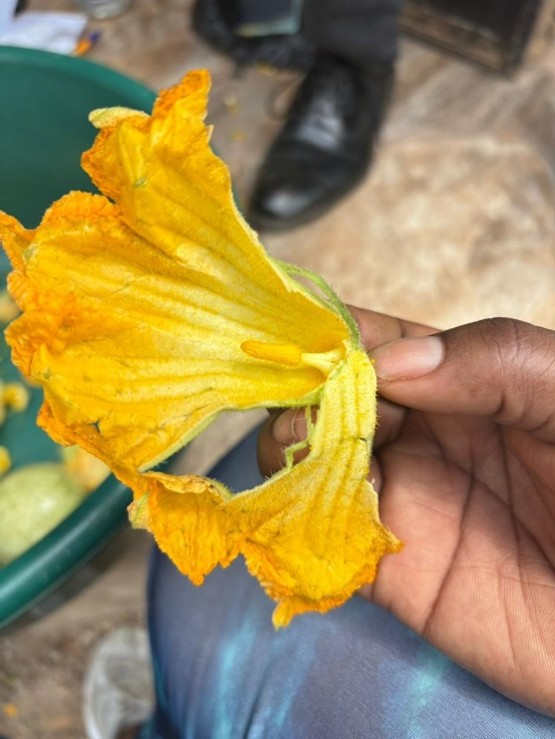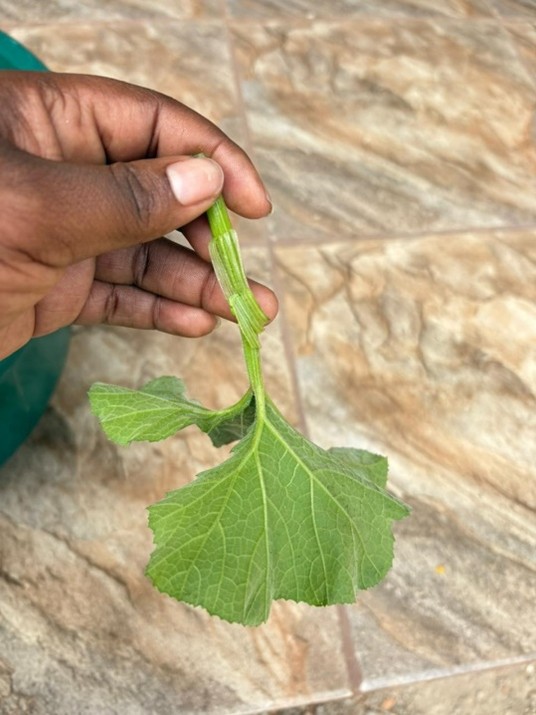Plant science at the dinner table: pumpkin leaves
Pumpkin leaves are used as a “green” much like spinach, beet or turnip greens throughout the world.

Yes, pumpkin leaves. While in the U.S. we generally eat the fruit of the pumpkin – which is scientifically a berry, in many countries around the world, people also eat the pumpkin leaves. Pumpkin fruit is eaten in both sweet and savory dishes: pies, cakes, sweet breads, soups, pasta dishes and more. Conversely, pumpkin leaves are used as a “green” much like spinach, beet or turnip greens.
Although not unique to South Africa, I was introduced to the culinary uses of pumpkin leaves through Eunice Mashao, of South Africa. Eunice was visiting Michigan State University Extension as a professional fellow in Michigan State University’s Advancing Young Women Agribusiness Entrepreneurs and Innovators Program this fall. As a farmer who grows a variety of crops on her farm, Eunice’s specialty is leafy greens, which she wholesales to markets in the surrounding areas. Eunice also grows pumpkins, both for the fruit and greens.
Here are some fun facts about pumpkins and pumpkin leaves:
- Pumpkins belong to the Cucurbitaceae family, along with cucumbers, squash and melons.
- Every part of the pumpkin plant above the ground is edible.
- Pumpkin leaves go by many different names throughout the world. In South Africa, they are generally called morogo or muroho, which is a general term for leafy greens.
- Pumpkin leaves are a source of vitamins A, B and C. These vitamins encourage healthy skin and vision, immune function, wound healing and iron absorption.
- Pumpkins leaves are also high in phosphorus and potassium, which support energy and muscle functions.
- Pumpkins leaves are a source of iron and calcium, which help with red blood cell production, cognitive function and bone strength.
- Pumpkin leaves also possess beta-carotene and high phenolic levels, helping to reduce inflammation and age-related macular degeneration.
- The fiber in pumpkin greens encourages good digestion.
- Historically, pumpkin leaves have been used in herbal medicine throughout Africa.
- Pumpkin leaves may be consumed raw, dried, steamed, sautéed or cooked and are often used in place of greens like spinach.
- Pumpkin leaves are frequently tossed into salads or blended into smoothies.
- Pumpkin leaves can be stored for up to three days in a plastic bag in a refrigerator.
- Pumpkin leaves are available year-round in warm climates.
During her time here, Eunice gave me a lesson on how the leaves are eaten in her culture and how to prepare them. Together, we would like to share a bit of culture through a traditional South African recipe called Morogo wa ditahaka, made primarily from pumpkin leaves.
Morogo wa ditahaka (pumpkin leaves)
Ingredients
- 2 bunches of green, young pumpkin leaves
- 3 pumpkin flowers, including the marrows (the flowers' ovaries)
- 1 ¼ cups
- 3 ripe tomatoes
- 2 cups peanut powder (finely ground peanuts)
- 1 teaspoon of baking soda
- 1 teaspoon of salt

Preparation
- Clean the stems of the leaves. Because the leaves and stems are slightly prickly, you will need to strip them of their fibrous strings (see photo).
- Clean the flower by removing the stalk inside the flower.
- Cut the marrows harvested from the same the vine.
- Wash the leaves and cut into small pieces.
- Cut three ripe tomatoes.
- Grind the peanuts into powder.

Cooking
- Add 1 ¼ cups water to a pan and bring to a boil.
- Add the cut marrows and simmer for two minutes.
- Add the flowers and simmer for five minutes.
- Add cut tomatoes and salt. Simmer for one minute.
- Add baking soda then add the pumpkin leaves. Simmer for six minutes.
- Add the peanuts while mixing and let simmer for six minutes.
- Mix well for a creamy consistency and serve with pap (a staple starch prepared from maize meal or sorghum powder) or your choice of starch.

Enjoy this cultural treat from South Africa. I personally can’t wait to try this recipe, hopefully sometime soon in South Africa with my friend Eunice!



 Print
Print Email
Email





